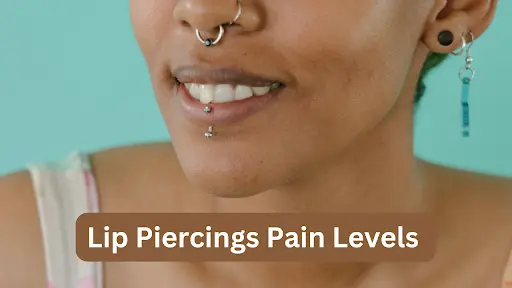Introduction: Lip Piercings Pain Levels
When it comes to lip piercings one of the biggest concerns is the pain. Knowing the pain levels of lip piercings is important for preparation and aftercare. Lip piercings pain levels – what you need to know will help you decide if you want to get a lip piercing and be ready for it. In this guide we’ll go through the different types of lip piercings and the pain levels and give you tips on how to handle the discomfort.
What Are Lip Piercings?
Lip piercings are body modifications that involve piercing the skin on or around the lips to insert jewelry. These piercings can be placed on the lower lip, upper lip or even in the corners of the mouth. The pain you’ll feel during the piercing process depends on where the piercing is placed and the type of jewelry you choose.
The pain varies from person to person but knowing the pain levels of lip piercings is important before you go through with it. Lip piercings pain levels – what you need to know will help you set your expectations and reduce the anxiety of the pain.
Pain Levels for Different Lip Piercings
When it comes to lip piercings pain, you need to consider the type of piercing and the location. Each piercing type and its placement on the lip can be different. Here’s a breakdown of the pain levels for different lip piercings:
1. Labret Piercing Pain Level
Labret piercing is one of the most common lip piercings. It’s a stud in the center of the bottom lip. Pain level is mild to moderate as the area has less nerve endings compared to other parts of the face. It will feel like a sharp pinch at first but the pain will subside quickly after. Aftercare is key to minimize swelling or discomfort after piercing.
2. Medusa Piercing Pain Level
Medusa piercing is above the upper lip, in the middle of the philtrum (the groove between the nose and upper lip). Pain level is moderate as the area has more nerve endings than the lower lip. Many people describe it as a sharp pinch. Some swelling and soreness can occur but usually heals without much discomfort after the first few days.
3. Vertical Labret Piercing Pain
A vertical labret piercing goes through the bottom lip and the pain is moderate to high. It’s because you’re piercing through both the top and bottom of the lip which can be a bit more intense. But it’s quick and the pain goes away once the jewellery is in. Make sure to follow aftercare to prevent infection as this piercing can swell.
4. Side Labret Piercing Pain
The side labret piercing is on the left or right side of the lower lip. The pain is mild to moderate, same as the standard labret piercing. Since the side labret doesn’t go through the most sensitive parts of the lip, it’s generally less painful than a vertical labret piercing. Most people describe it as a quick pinch that fades away.
5. Angel Bites Piercing Pain
Angel bites piercing is two piercings on either side of the upper lip. This piercing can be moderate in discomfort as it’s two separate punctures. The pain isn’t overwhelming but some people may find it a bit more painful than a single lip piercing because of the multiple entry points. Swelling may occur but proper care should alleviate most of the discomfort.
6. Smiley Piercing Pain
A smiley piercing is inside the upper lip and through the frenulum (the thin strip of tissue connecting the upper lip to the gums). The pain level is low to moderate. Since the frenulum is less sensitive than the rest of the lip area the pain is minimal. There may be some irritation during the healing process but the initial pain is very short.
7. Cheek Piercing Pain Level
Not a “lip piercing” per se, but often grouped with lip piercings. Pain level is moderate as it’s piercing through soft tissue of the cheek. Not as painful as some other facial piercings but may be more uncomfortable during health as the area is prone to irritation.
Factors that affect Lip Piercing Pain
When choosing a lip piercing, consider these factors:
- Piercing Location: The placement of the piercing has a big impact on the pain level. Areas with more nerve endings like the upper lip or corners of the mouth are more sensitive than the lower lip.
- Pain Tolerance: Everyone’s pain tolerance is different, what’s painful for one person may not be as bad for another. If you have a high pain tolerance you may find the procedure more manageable.
- Piercing Technique: The piercer’s skill also plays a big role in the level of discomfort. A skilled piercer can make the process smoother and less painful while an inexperienced piercer can cause more discomfort.
- Jewelry: The type of jewelry used can also affect pain level. A small stud is less painful than a larger hoop or barbell as it causes less tissue movement.
- Healing Process: While the initial pain goes away quickly, the healing process can be uncomfortable. Swelling, tenderness and irritation is common in the first few days after getting a piercing.
How to Manage Lip Piercing Pain
While lip piercings pain level – what you need to know can help set expectations, managing the discomfort is just as important. Here’s how:
- Take Pain Relievers: Over the counter pain relievers like ibuprofen can help with pain and swelling during the healing process.
- Follow Aftercare Instructions: Proper aftercare is key to avoiding infection and discomfort. Follow the instructions provided by your piercer which usually includes cleaning the piercing with saline solution and not touching the area with dirty hands.
- Ice the Area: Applying a cold compress or ice pack to the area can help with swelling and discomfort.
- Don’t Smoke and Drink: Smoking and drinking can increase the risk of infection and slow down the healing process which means more discomfort.
- Stay Hydrated and Eat: A healthy diet and staying hydrated can speed up the healing process, makes the whole experience more comfortable.
Conclusion
Preparation for your piercing is essential, and understanding lip piercings pain levels – what you need to know – is part of this. The pain is usually manageable and temporary, but everyone’s experience differs on many different factors. If you want a labret, medusa, or smiley piercing, being aware of what to expect from the pain, and how to care for this new piercing afterwards, will ensure you a pleasant experience. You can have your new lip piercing without inconvenience by following proper after care and managing the discomfort.



